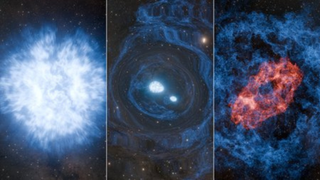Latest about Stars

Hubble Telescope spies 'wake' of supergiant Beutelgeuse's hidden companion star
By Julian Dossett published
Using new observations from the Hubble Space Telescope and observatories on Earth, scientists have confirmed the existence of Betelgeuse's elusive companion star, named Siwarha.

Hubble telescope discovers a new type of cosmic object and astronomers are on 'Cloud 9'
By Robert Lea published
"This is a tale of a failed galaxy."

Carina Nebula shines with white-blue stars | Space photo of the day for Jan. 5, 2026
By Kenna Hughes-Castleberry published
The Westerlund 2 star cluster is home to some of the Milky Way's brightest stars.

What old, dying stars teach us about axions as a candidate for dark matter
By Paul Sutter published
The axion could be a contender to explain the mystery of dark matter.

'Dracula's Chivito' looks stunning in this tasty Christmas photo from the Hubble Telescope
By Robert Lea published
Using the Hubble space telescope, astronomers have imaged "'Dracula’s Chivito" the largest site of planetary birth ever seen.

Planet-eating stars hint at Earth's ultimate fate
By Matthew R. Francis published
A sampling of aging Sun-like stars demonstrates that they likely eat their closest planets.

Astronomers may have spotted the 1st known 'superkilonova' double star explosion
By Robert Lea published
"We do not know with certainty that we found a superkilonova, but the event nevertheless is eye-opening."

Astronomers capture 1st direct images of collisions in a nearby star system: 'It's like looking back in time'
By Robert Lea published
"It's like looking back in time in a sense, to that violent period of our solar system when it was less than a billion years old."
Breaking space news, the latest updates on rocket launches, skywatching events and more!


